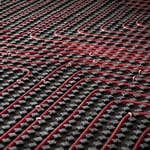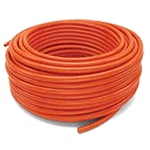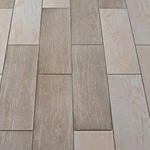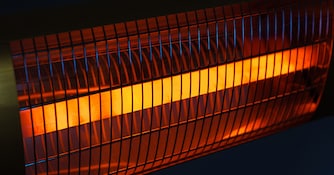
Enjoy Warm Feet with Radiant Heat
Feet seem to be the toughest part of your body to warm up during winter. When you do get them warm, though, it's one of the most relaxing things in the world because your whole body seems to get toasty.
What if I said you could enjoy warm feet all winter long in your home with radiant floor heating? "How does radiant floor heating work," you ask? Read on to find out.
What is Radiant Heat?
 Radiant heat is a series of hot-water tube or electric wires buried below the floor that radiates heat up to the surface to warm your feet and body.
Radiant heat is a series of hot-water tube or electric wires buried below the floor that radiates heat up to the surface to warm your feet and body.
There are multiple types of radiant floor heating available, which means the right solution for you is out there and ready to be put into your home.
Types of Radiant Floor Heating
The two main types of radiant floor heating are hydronic and electric. Hydronic radiant floor heating is more cost-effective if you are building a new home and planning on using the system to heat the entire house.
However, installing a hydronic system in an existing home involves ripping up all of the flooring and connecting new tubing to existing hydronic systems, which can be very expensive and labor intensive. Therefore, if you are renovating an existing home or only planning on heating part of your new home, an electric system might be the way to go.
Before going any further into the pros and cons of each system, lets talk about what they each consist of.
Hydronic Radiant Floor Heating Systems
 In a hydronic radiant floor heating system, your heating can come from either your boiler or water heater. The boiler or water heater sends water to a manifold, where many pipes branch out to various areas of your home.
In a hydronic radiant floor heating system, your heating can come from either your boiler or water heater. The boiler or water heater sends water to a manifold, where many pipes branch out to various areas of your home.
By using a manifold, thermostats can adjust the temperatures of specific zones by regulating the temperature of water flowing into each pipe. Typically, water is sent from the manifold to each room through
PEX tubing
(a strong material that can withstand extreme temperatures) by circulation pumps.
The PEX tubing is laid out under the floor, covering as much square footage as the homeowner would like. Depending on the homeowner's preference and/or architectural restrictions, the tubing is placed either directly underneath the subfloor (dry install) or within a sheet of concrete (wet install).
The sheet of concrete is used to store the heat radiating from the tubing and spread it evenly over a large area. Because it retains heat so well, the concrete is an efficient way to transfer heat to the room. While dry installs are cheaper and get hot much more quickly than wet installs, they require a higher operating temperature, since some heat is lost in the air below the floor while it is being transferred to the room.
Electric Radiant Floor Heating Systems
 Electric radiant floor heating systems are a bit simpler.
Electric radiant floor heating systems are a bit simpler.
In fact, while hiring a contractor is always recommended, electric systems are generally simple enough to install on your own.
Instead of a spread of PEX tubing underneath the floor, resistance wires (a.k.a. heating coils) are run through a large plastic mat in a similar pattern as the PEX tubing.
This mat is then placed directly underneath the flooring and connected to a thermostat. Tile or wooden floor panels can be laid directly on the mats, facilitating the installation. As electricity is sent through the wires in the mat, it creates heat that transfers to the floor above.
Is Radiant Floor Heating Worth It?
 As mentioned above, hydronic radiant floor heating systems can be rather expensive to install, so they only make sense for new construction. They are generally low-maintenance, but if they do break, fixes can be rather expensive and will require professional attention.
As mentioned above, hydronic radiant floor heating systems can be rather expensive to install, so they only make sense for new construction. They are generally low-maintenance, but if they do break, fixes can be rather expensive and will require professional attention.
Electric radiant floor heating systems are typically more expensive to run since they rely on electricity, but their ease of installation and practically maintenance-free setup make them appealing for renovations or additions.
Additionally, electric systems are great options for single room heating, such as the bathroom, or snow melting. If you live in a location where snow comes down in barrels, installing
radiant floor heating in your driveway
can be a great way to save time shoveling.
Some people like to save money by installing a system only in certain spots of the driveway, clearing just enough space to make tire tracks for their car to pull in and out of the garage.
Consider Your Floor Type
 One more thing to take into account when deciding on whether or not to use radiant floor heating is the type of flooring you wish to have in the to-be-heated space. Tile is the best material to use for radiant floor heating, since it both conducts and stores heat very well.
One more thing to take into account when deciding on whether or not to use radiant floor heating is the type of flooring you wish to have in the to-be-heated space. Tile is the best material to use for radiant floor heating, since it both conducts and stores heat very well.
If you wish to use carpet, make sure it's a thin carpet, as thicker carpet will further insulate the floor, causing the system to need to run at a higher temperature to achieve the same result.
This means that the thicker the carpet, the more energy is required to heat the room and the more money you'll have to pay. Wood floors can work with radiant heating systems, but solid wood may shrink or crack due to the decrease in humidity from exposure to heat.
Aesthetics and Convenience of Radiant Floor Heating
 Radiant floor heating systems not only heat your floor, but can heat your entire room as well. This means you can design a room without any visible heating equipment - no baseboard radiators or unit heaters sticking out of the wall.
Radiant floor heating systems not only heat your floor, but can heat your entire room as well. This means you can design a room without any visible heating equipment - no baseboard radiators or unit heaters sticking out of the wall.
While radiant systems typically cost more upfront than forced-air systems, they are much more efficient since there is minimal loss of heat during the supply process. Forced-air systems, on the other hand, are forced to deal with heat loss as the heated air travels through air ducts to its intended destination.
For more information on which radiant floor heating system is best for you, speak with the experts at
eComfort.com today.



